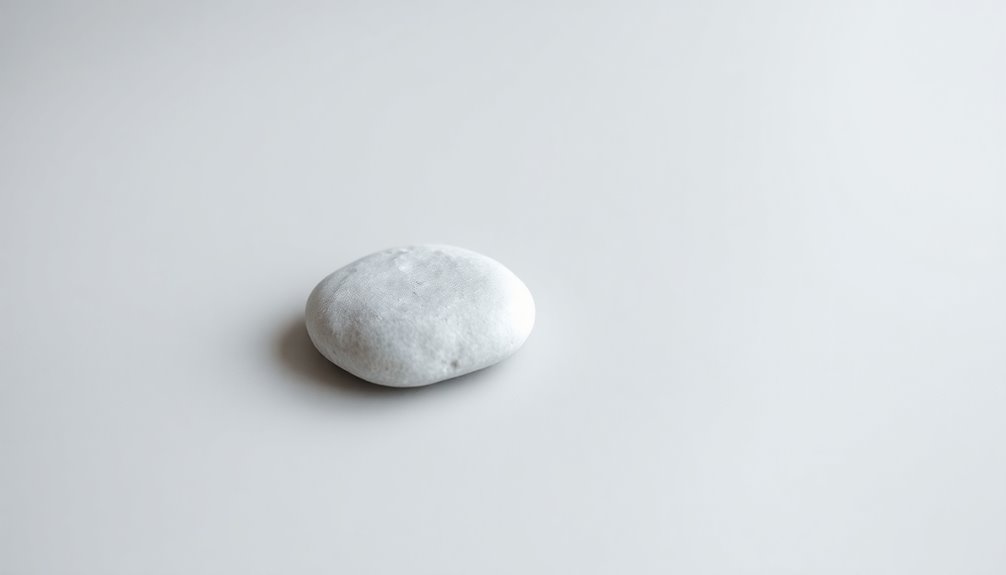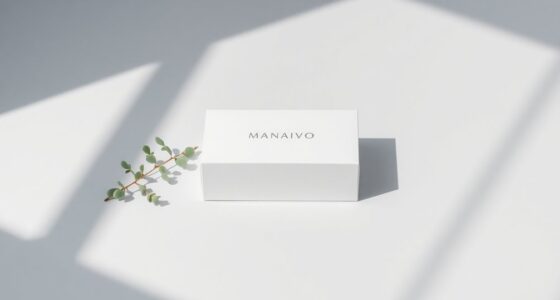Minimalist photography helps you capture simplicity by focusing on a single subject and eliminating distractions. You emphasize negative space, enhancing the subject's impact. Using limited colors and clean lines creates a cohesive visual experience. You'll want reliable equipment like a prime lens and a sturdy tripod to guarantee sharp images. Mastering composition techniques, light, and shadow are essential. If you're curious about the different types and effective tips for this art form, there's plenty more to explore.
Key Takeaways
- Embrace the "less is more" philosophy by focusing on a single subject and eliminating distractions in your composition.
- Utilize negative space effectively, aiming for 70%-90% to enhance the visual impact of your subject.
- Select a limited color palette for cohesive visuals that guide the viewer's attention without overwhelming them.
- Experiment with shallow depth of field and the rule of thirds to create balanced and engaging compositions.
- Capture images during golden hour to achieve softer shadows and warmer tones, enhancing the emotional resonance of your photographs.
Understanding Minimalist Photography
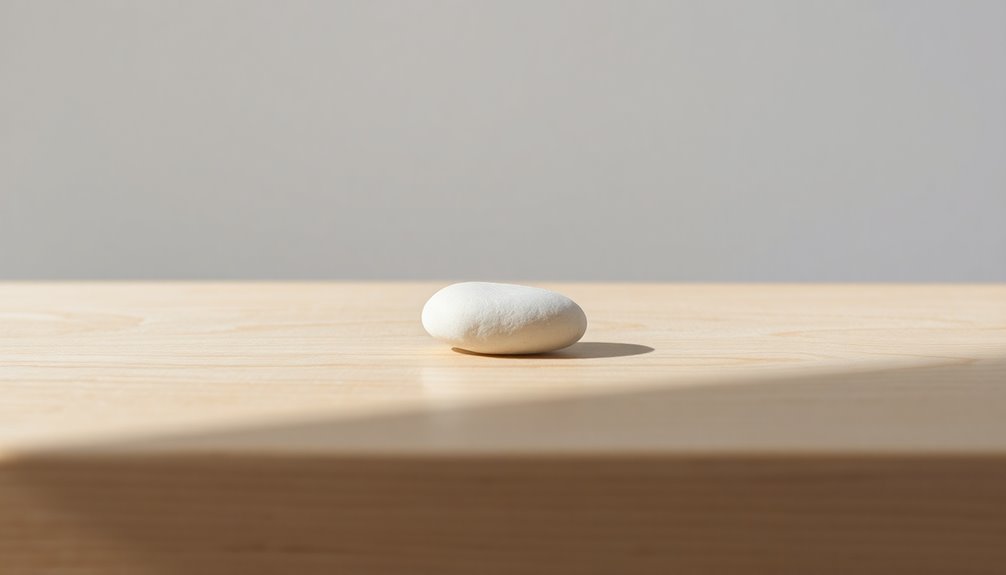
While you explore the world of minimalist photography, you'll quickly discover that it embraces the idea of "less is more." This style focuses on simplicity by honing in on a single subject, stripping away distractions that might dilute its impact.
By utilizing negative space, you create breathing room around your subject, enhancing its visual impact. Strong composition is key; arranging lines and shapes thoughtfully draws the viewer's eye and tells a compelling visual story.
Isolating the subject against a plain background amplifies its importance, allowing emotions to resonate. Whether you're capturing architecture photography or black and white images, minimalist photography thrives on the essence of simplicity, showcasing how powerful a single element can be in your visual narrative. Additionally, understanding emotional instability can enhance the depth of your subject portrayal, as it often reflects the human experience.
Core Principles of Minimalism
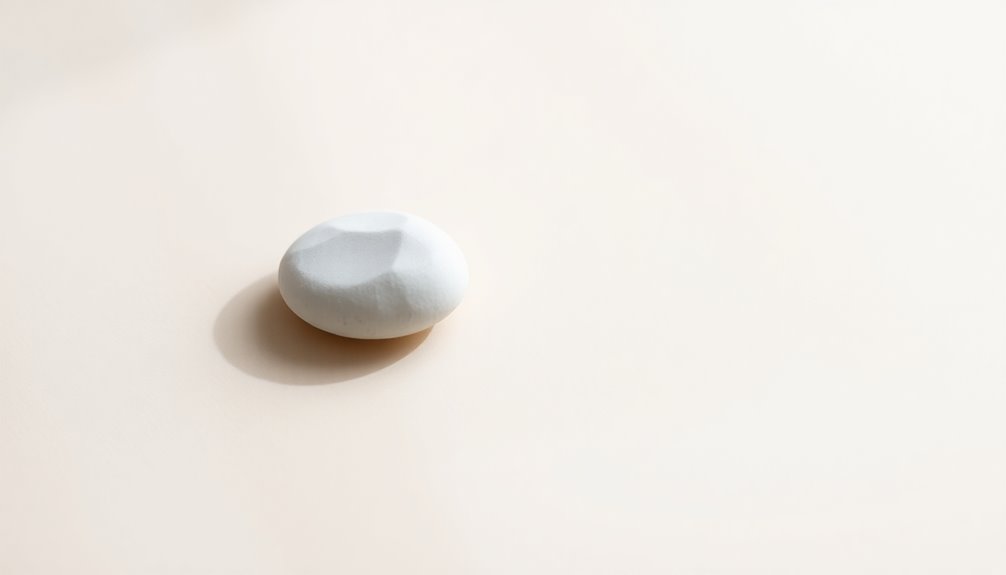
In minimalist photography, you'll find that negative space plays a key role in emphasizing your subject. By focusing on strong composition, you can create balance and guide the viewer's eye where you want it to go. Together, these principles elevate your images, transforming simple scenes into striking visual statements. The use of natural materials in interior design can inspire a minimalist approach, where simplicity and authenticity shine through in every shot.
Emphasis on Negative Space
Negative space plays an essential role in minimalist photography, as it surrounds and isolates your main subject, giving it room to breathe.
By utilizing ample negative space—aiming for 70%-90% of the frame—you create a balanced composition that draws attention directly to your focal point, enhancing its significance.
This approach can evoke a calming mood, allowing for deeper emotional resonance with your audience.
Often, negative space works beautifully with a limited color palette, resulting in cohesive visuals that communicate simplicity and clarity.
Mastering negative space can transform ordinary subjects into powerful images, where the surrounding emptiness amplifies your subject's significance.
Embrace this technique to elevate your photography and captivate viewers with striking, memorable compositions. Additionally, just as color accuracy enhances the visual experience in projectors, it can also play a crucial role in the effectiveness of minimalist photography.
Importance of Strong Composition
Strong composition is essential in minimalist photography, as it directs the viewer's focus and enhances the overall impact of your images. By applying the rule of thirds, you create balance and visual interest that lead the eye to the focal point.
Utilizing negative space not only emphasizes simplicity and focus but also provides breathing room for your subject. Effective use of lines and shapes guides the viewer's gaze, establishing a narrative through the arrangement of essential elements.
Isolating subjects from their surroundings heightens their significance and emotional impact. Maintaining a consistent minimalist aesthetic fosters a cohesive visual experience, allowing each element to resonate powerfully with viewers. Additionally, understanding color palette selection can further refine your compositions by ensuring that colors harmonize with the minimalist theme.
Strong composition is your key to creating compelling minimalist photographs.
The Elements of Minimalism in Photography

While many photographers fill their frames with details, minimalist photography thrives on simplicity by isolating one or two key elements. By eliminating distractions, you enhance the visual impact of your main subject. Utilizing negative space is essential; it provides breathing room and emphasizes significance. Remember, composition is important—applying the rule of thirds can guide your viewer's eye effectively. A limited color palette maintains cohesiveness and prevents overwhelming visuals, while strategic contrast can highlight your subject. Techniques like shallow depth of field and intentional framing emphasize the core essence of your image. Additionally, understanding the importance of energy-saving features in modern technology can inspire a minimalist approach in your photography by focusing on efficiency and clarity.
| Element | Description | Purpose |
|---|---|---|
| Negative Space | Space around the main subject | Enhances focus on simplicity |
| Limited Color Palette | Fewer colors to create harmony | Avoids overwhelming the viewer |
| Shallow Depth of Field | Blurs background for clarity | Emphasizes the main subject |
Essential Equipment for Minimalist Photography

When you're gearing up for minimalist photography, the right equipment is key to achieving that clean and simple aesthetic.
You'll want a reliable camera, whether it's a DSLR or your smartphone, paired with a prime lens to help isolate your subjects.
Don't forget a sturdy tripod to keep your shots steady and maintain that sharp focus on simplicity. Additionally, using a well-draining soil mix for your plant subjects can enhance the overall aesthetic of your minimalist compositions.
Camera Gear Essentials
To capture the essence of minimalist photography, you'll need more than just a good eye; having the right camera gear is crucial. Start with a camera and a prime lens, preferably one with a wide aperture like 50mm f/1.8, to create a shallow depth of field that enhances simplicity. A sturdy tripod guarantees stability, especially for long-exposure shots, improving image quality.
Here's a quick overview of camera gear essentials:
| Gear Type | Purpose |
|---|---|
| Prime Lens | Isolates subjects with shallow depth |
| Tripod | Provides stability for long exposures |
| Flash | Enhances clarity and adds depth |
Set your aperture to f/8 and maintain a lower ISO around 100 for peak clarity in your minimalist compositions. Additionally, consider using a camera with advanced filtration systems to improve image quality by reducing lens flare and enhancing contrast.
Recommended Lens Types
Choosing the right lens is essential for achieving the simplicity and focus characteristic of minimalist photography. A prime lens with a wide aperture, like a 50mm f/1.8, is perfect for creating a shallow depth of field, isolating your subjects beautifully.
If you prefer versatility, a kit lens, such as an 18-55mm, allows you to explore various minimalist scenes, from landscapes to portraits. For expansive spaces, consider wide-angle lenses (24mm or 35mm) to maintain focus on a singular subject. Telephoto lenses (85mm or 135mm) help compress distances, emphasizing simplicity in your composition.
Regardless of your choice, using a tripod enhances stability and precision, especially in low-light conditions, ensuring you capture those stunning minimalist scenes effectively. Additionally, understanding estate planning can help you preserve and share your photographic legacy with future generations.
Camera Settings for Minimalist Shots
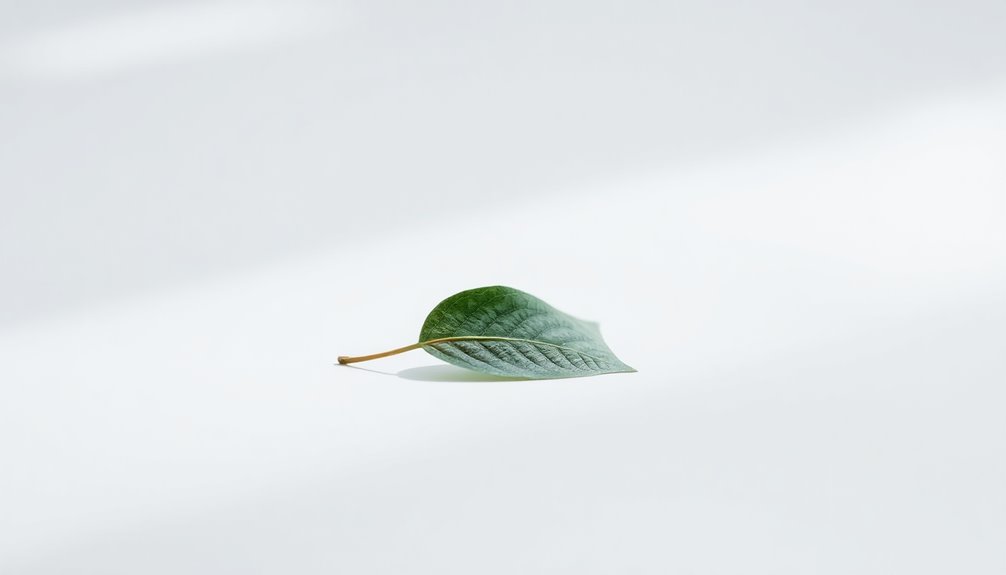
As you explore the art of minimalist photography, mastering your camera settings is essential for capturing clean and striking images.
Start with an aperture setting of f/8 to achieve a great depth of field while keeping your subject sharp. Use a shutter speed of at least 1/80s for handheld shots to avoid motion blur; a tripod can help for longer exposures.
Keep your ISO low, around 100 or 200, to reduce noise and enhance clarity in your composition. Consider shooting in RAW format for greater flexibility in post-processing, allowing you to adjust exposure and contrast without losing quality.
Using manual settings lets you fine-tune these elements, ultimately isolating your subject against a clean background that defines minimalist photography. Additionally, engaging in STEM toys can enhance your understanding of light and composition, further improving your photographic skills.
Different Types of Minimalist Photography

Understanding camera settings sets a solid foundation, but the beauty of minimalist photography truly shines through its various styles.
In landscape photography, you'll focus on few elements, like a solitary tree, often capturing light and shadow during golden hour for mood.
Minimalist architecture emphasizes clean lines and geometric shapes, isolating structures against plain backgrounds to showcase their design.
Minimalist architecture highlights sleek lines and shapes, presenting structures against simple backdrops to celebrate their design.
Aesthetic photography utilizes negative space, allowing everyday objects to stand out against uncluttered settings.
In portrait photography, careful composition places the subject against simple backdrops, drawing attention to expressions and emotions.
Each style offers unique visual impact, encouraging you to explore subtle textures and forms that resonate with simplicity and elegance. Additionally, consider incorporating natural materials to enhance the organic feel of your compositions.
Composition Techniques in Minimalist Photography
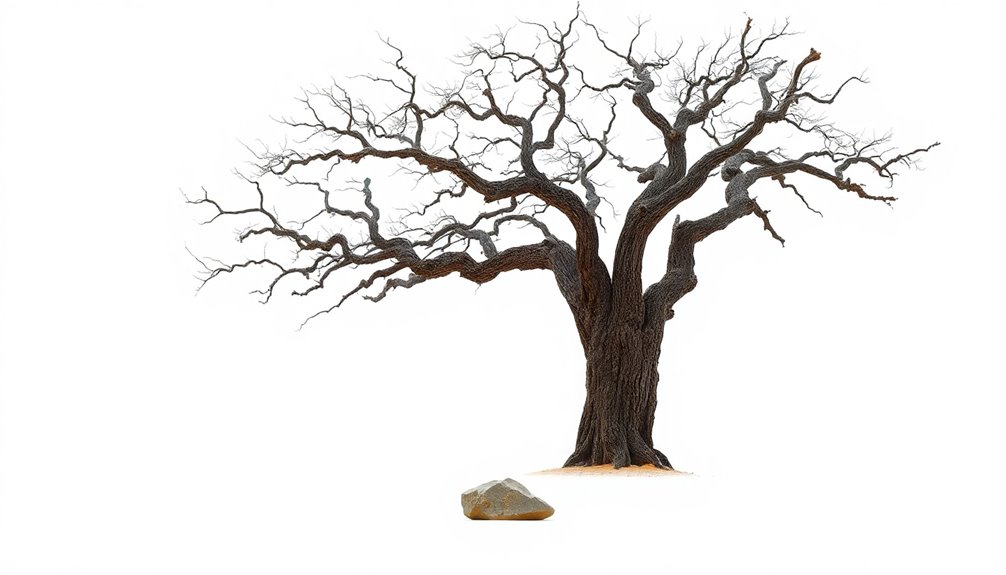
Mastering composition techniques is essential for creating impactful minimalist photography. Start by employing the rule of thirds to balance composition, positioning your subject at the intersections to draw the viewer's eye.
Utilize negative space to isolate your subject, enhancing its prominence and creating tranquility. Focus on geometric shapes and leading lines to guide the viewer's gaze, adding structure to your image.
Simplify the frame by eliminating distractions; every visual element should serve a purpose in your narrative. Experiment with the interplay of light and contrasting colors to emphasize your subject, ensuring it resonates with the minimalist aesthetic.
The Role of Light and Shadow
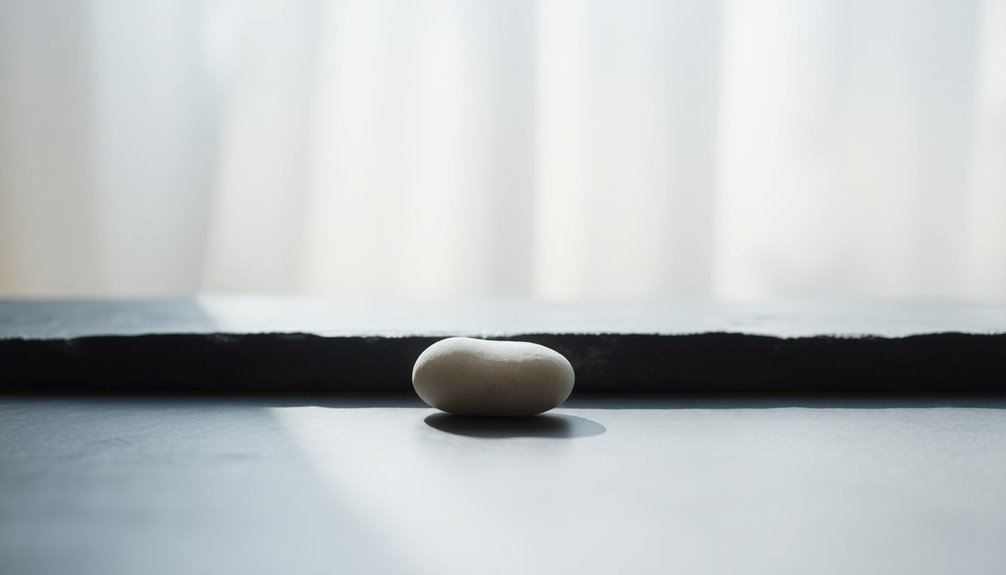
Composition techniques set the stage for impactful minimalist photography, but the role of light and shadow takes your images to another level.
Mastering the interplay of light and shadow can create depth and enhance the overall mood of your shots. Here's how to make the most of it:
- Use natural light during golden hour for softer shadows and warmer tones.
- Experiment with high contrast to evoke emotions and emphasize the subject.
- Understand the direction and quality of light to manipulate shadows, simplifying your scenes.
Tips for Mastering Minimalist Photography

While capturing minimalist photography might seem straightforward, it requires a keen eye for detail and intentionality in your approach. Focus on a singular subject, utilizing negative space to occupy 70%-90% of the frame; this enhances isolation and visual impact.
Use a wide aperture setting, around f/8, to achieve a shallow depth of field, making your subject stand out against a blurred background. Incorporate the rule of thirds to create balanced minimalist compositions that guide the viewer's eye to the focal point while maintaining simplicity.
Experiment with a monochromatic color palette to eliminate distractions and emphasize form and texture. Finally, carry a tripod for stability, especially during long exposures, ensuring sharpness in your enthralling minimalist images.
Frequently Asked Questions
What Are Some Common Themes in Minimalist Photography?
When you think about common themes in minimalist photography, consider elements like isolation, simplicity, and negative space.
You'll often find stark contrasts and a focus on shapes and lines that draw attention to the subject. Nature, architecture, and everyday objects frequently serve as subjects, highlighting their inherent beauty.
By stripping away distractions, you create a sense of calm, allowing viewers to appreciate the elegance in simplicity.
It's all about conveying more with less.
How Do I Find Inspiration for Minimalist Photography?
To find inspiration for minimalist photography, start by observing your surroundings.
Look for simple shapes, lines, and colors that catch your eye. Experiment with different angles and perspectives; sometimes, a slight shift can reveal a striking composition.
Explore online galleries, social media, or photography books focused on minimalism. Engage with nature, architecture, or everyday objects, allowing your creativity to flow as you simplify and frame your subject beautifully.
Can Minimalist Photography Be Edited Digitally?
You might think of digital editing as a way to sprinkle a little magic on your photos.
Yes, minimalist photography can absolutely be edited digitally! You can enhance colors, adjust contrast, or even crop to emphasize simplicity.
Just remember, the goal is to maintain that clean, uncluttered feel. It's all about refining your vision without overwhelming the image.
What Are the Benefits of Practicing Minimalist Photography?
Practicing minimalist photography helps you focus on the essentials, stripping away distractions to highlight your subject.
It enhances your creativity, encouraging you to see beauty in simplicity. You'll develop a keen eye for composition and balance, which can improve all your photography skills.
Plus, it's a great way to find peace in your surroundings, allowing you to appreciate the little things.
How Do I Develop My Own Minimalist Photography Style?
To develop your own minimalist photography style, start by simplifying your compositions.
Focus on one or two subjects, and eliminate distractions in your frame. Experiment with negative space to enhance your subject's impact.
Use natural light to create mood and texture, and pay attention to color palettes that resonate with you.
Regularly review your work to identify patterns and preferences, and don't hesitate to seek inspiration from others while staying true to your vision.
Conclusion
In a world bursting with distractions, embracing minimalist photography feels like a radical act. You'd think capturing less would mean saying goodbye to creativity, but ironically, it's quite the opposite. By stripping away the clutter, you actually discover deeper stories and emotions. So, grab your camera, simplify your scene, and watch as the beauty of simplicity unfolds. Who knew that doing less could lead to so much more? Immerse yourself and let the simplicity speak volumes!
